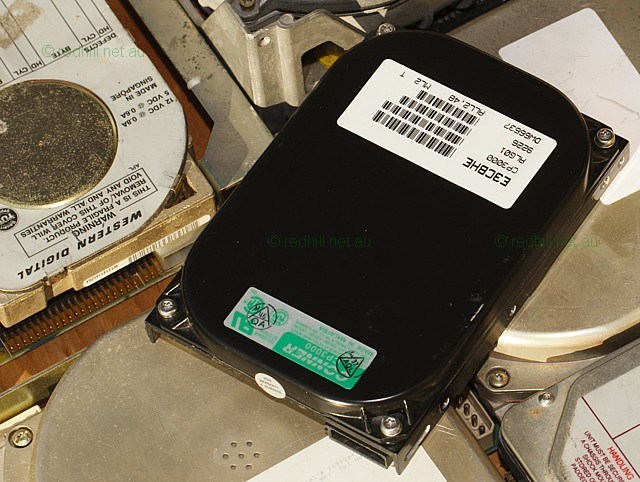
Photo: Red Hill.
Conner CP3000
Conner produced a bewildering variety of drives; often the variations seemed quite senseless. For example, why produce two different single-platter 40MB drives with almost identical performance characteristics at the same time? Conner did — the CP3000 (42MB, 28ms) and the CP3044 (43MB, 25ms) were both 1990 products. There doesn't seem to be any surviving documentation now, but the CP3041 was apparently yet another version of the same basic drive — this one made exclusively for Compaq.
But there was method in Conner's madness. Rather than design a drive, manufacture it, then offer it to buyers, Conner often worked the other way around: first get a contract with an OEM for a specified number of drives with certain guaranteed performance characteristics, then design it, buy in the parts, and finally assemble it. It was a very successful business model: Conner's explosive growth over the years between 1986 and about 1992 or so was the proof. Later on, conditions changed and the policy became unsustainable. But the decline of Connor is a story for another page.
Individual drives for individual contracts aside, Conner believed in making frequent small design changes, and the chaotic assortment of different Conner drive models in the manuals reflects this.
The CP3000 was a very common drive through the early nineties, though you would also see quite a few of the variants. Back then we didn't really pay too much attention: Conners were Conners, and despite the multiplicity of models they never seemed to change much.
Illustration: The Conner CP3000 looks very small and modern alongside some of the old-school 40MB drives that it replaced. (Top left, Western Digital 93044A; lower left, Seagate ST-251.) The visual impression is accurate: these early Conners really were a vast improvement. Within a few years, nearly all drives would look like this.
| Performance | 0.36 | Reliability | AA2 |
| Data rate | 12 Mbit/sec | Spin rate | 3557 RPM |
| Seek time | 28ms | Buffer | 8k |
| Platter capacity | 42MB | Encoding | RLL |
| Form | 3½ slimline | Interface | IDE mode 0 |
| CP3000 | 42MB | 2 ferrite heads | 1990 |